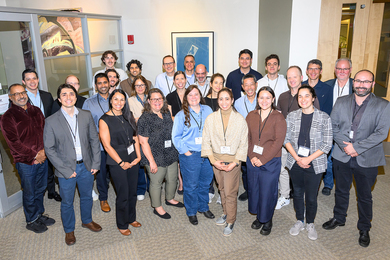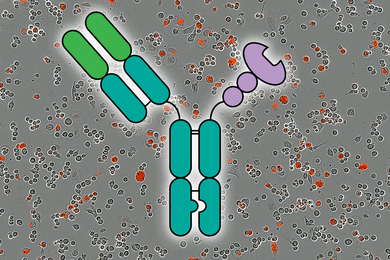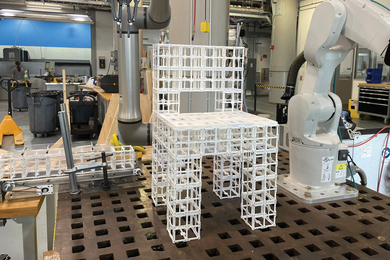The Management Reporting Project has announced the plan for completing the rollout of SAP to the MIT community. The rollout will be broken up into five phases, or project "milestones."
"The time has come to move forward expeditiously to finish the rollout of SAP and meet the management reporting goals that were set by the Institute four years ago," said Katherine Cochrane, manager of the Management Reporting Project. "MIT has a great transactional and reporting tool in SAP. We are looking forward to using the richness of the SAP environment that will be available when we finish the rollout and end our dependency on the legacy systems."
The first milestone consists of a series of informational meetings, designed to familiarize the community with the plan for the rollout, and the preparation work that will be required. This milestone began on March 25 and continues through April 14. A summary of the information meetings may be found on the Management Reporting web site at http://web.mit.edu/reeng/www/finsys/status.html.
To follow up on the status report sessions, a series of "concept workshops" are being held to provide more detailed information on MIT's SAP financial architecture, the MIT reporting strategy, purchasing with SAP, and the setup of a department's requisition approval process. The workshops will be given again on April 14 from 9am-3pm in the Student Center Mezzanine Lounge. No registration is required. Call Robert Murray at x8-7318 for more information.
NEW REPORTING FUNCTIONS
Beginning on May 18, training will start for the Milestone 2 reporting-related SAP functions. These reporting functions will supplement the reporting capabilities that were part of the Phase 1 rollout last fall. Tasks included in this group are running new SAP reports, reserving funds for future anticipated expenditures, and creating a departmental budget plan. Some of these tasks require special authorizations.
Reports using SAP's Executive Information System (EIS) will also be made available to users authorized by their departments. EIS can be thought of as a collection of multidimensional dedicated databases called "information cubes."
EIS databases can be designed to cover virtually any kind of management reporting at MIT. Individual EIS databases, known as "aspects," collect information from various MIT sources, with the aim of presenting managers with a reporting view of a group; a department, lab or center; a School; or the entire Institute.
Milestone 2 reporting training will continue through July 15, and then will be offered on a periodic basis.
Beginning in Milestone 2, the Computing Help Desk will begin to provide front-line triage of business questions, in addition to their current support for technical problems. A special e-mail address, saphelp@mit.edu>, has been set up to handle SAP questions.
MILESTONE 3
Milestone 3 includes six efforts that are to be rolled out between now and August 31. Because each has relatively few interdependencies with other SAP projects, it's possible for each to have a separate rollout plan for user training and for introduction to the MIT community. These tools are the MIT VIP Credit Card, the MIT Data Warehouse, an enhanced version of ECAT (Electronic Catalog) for the partner vendor NECX, and SAP electronic journal vouchers. They will be available on a rolling schedule between now and August 31. After August 31, they will be incorporated into the Milestone 4 training and delivery schedule.
To accomplish the Institute's 1998 fiscal year-end goals, SAP electronic journal vouchers will be used for the closing. The cutoff for paper journal vouchers will be June 24. The use of SAP for closing journal vouchers will dramatically speed up the closing time.
"The [MIT] Corporation Audit Committee asked us to provide financial results for the fiscal year earlier in 1998," said Controller James L. Morgan. "The faster we can deliver the fiscal year financial information, the more useful that information is. In addition, the federal government has shortened the deadline for the A-133 audit beginning in fiscal 98. We need to close the books a month sooner to assist in meeting these deadlines. SAP journal vouchers and online reporting will be helpful in meeting our goals." The closing takes place in the summer, following end of the fiscal year on June 30.
During Milestone 3, authorization to create journal vouchers and manual reservations will be given to SAP users who have authorization to display account summary and detailed transaction reports. This authorization scheme will be reconsidered prior to the beginning of Milestone 4.
Training for SAP journal vouchers will be available in a demo format during April. No registration is required for the demo classes. The training schedule can be seen on the SAP Training Web page at http://web.mit.edu/sapr3/training/.
The MIT VIP Card is a new tool developed for the MIT community with the intent of streamlining the procurement and payment process for small dollar purchases. There are two separate roles associated with the VIP Card. The first is the cardholder who will use the card to make small purchases. The second is the verifier, who will be the department person(s) who will verify, reallocate and post the charges as warranted.
The cardholder will not need any training or knowledge of SAP to use the card, but will be required to attend a one-hour cardholder training session before receiving their card. Once training has been completed, the VIP Card may be used to purchase authorized goods and services up to $500 per transaction. (This limit is currently under review and may be increased at some point in the future.) The use of the VIP Card should eliminate the need for many requisitions, purchase orders, blanket orders, DAPOs, Request for Payments (reimbursements) and petty-cash transactions.
The verifier will reallocate and post credit-card charges in SAP. They will need SAP access to perform a function similar to the current SAP journal voucher process. The verifier will also be required to attend a one-hour training session.
The ECAT project has been operational since March 1997 for three large-volume partner vendors. Goods may be purchased from Office Depot, VWR Scientific and BOC Gases simply by pointing and clicking on Web-based catalogs. The enhanced version of ECAT that will initially be used for NECX is due for full user rollout in May. It will allow purchasing of computers and computer-related supplies from NECX via the Web.
The MIT data warehouse has been developed to act as a single read-only data repository for SAP and other MIT systems, such as the Student Information, Proposal and Personnel systems. It will allow users to do "cross-system" reporting and download data to departmental databases.
PURCHASING
Starting in September, authorized users will be able to use the SAP and Web-based purchasing capability in Milestone 4. Once in SAP,they will have a rich set of requisitioning functions for both internal and external suppliers, complete with routing and approval capabilities. Streamlined approval processes will be used to facilitate requisition approval by MIT central departments such as the Office of Sponsored Programs and the Safety Office.
Occasional requisitioners such as graduate students may opt to utilize the simplified SAPWeb purchasing functions to create, route for approval, and display requisitions, as well as look up the status of purchase orders and vendor payments.
Also included in this milestone are salary planning and commitment capabilities, which will be available through the use of the MIT-developed Labor Distribution System (LDS). LDS, which appears as a menu choice within SAP, will provide a consistent tool for MIT departments, labs, and centers to analyze and manage labor and related effort costs. Authorized LDS users will be able to record current and future salary commitments by cost object; track and report labor costs and effort distribution, including vacation and change in hours, for current and upcoming appointments; view actual and committed salary detail by person; and view distributions by person within a cost object.
Training for Milestone 4 will be given from September to December 1998.
From September through the end of the year, some SAP infrastructure and future planning efforts will be completed. They include increasing the frequency of data feeds to and from SAP (such as Benefits, Library and Medical Accounts Receivable feeds); the development and rollout of the SAP Plant Maintenance module; and the establishment of standards and methods for the storage/archive of SAP transaction data.
NEW AND UPDATED REPORTS
There are some new and enhanced SAP reports now available to authorized users:
- The "Summary Statement" report prints in the landscape mode to include all available columns. The "Journal Vouchers Postings Report" shows journal voucher activity by cost object. "Purchasing Overview" reports can be run by vendor or by cost object. An improved "Payment Report" shows check stub information. SAP requisitions can now be printed. The "Cost Object Consolidation Report" allows the user to summarize the activity of many cost objects in one report. Access to this report may be obtained by contacting an "authorized requester" from the list on the SAPR3 home page at http://web.mit.edu/sapr3/.
There is a new program in the standard MIT "Accounting" menu called "Convert Legacy Architecture" that will translate legacy account numbers and object codes to SAP cost objects and cost elements.
A version of this article appeared in MIT Tech Talk on April 8, 1998.





